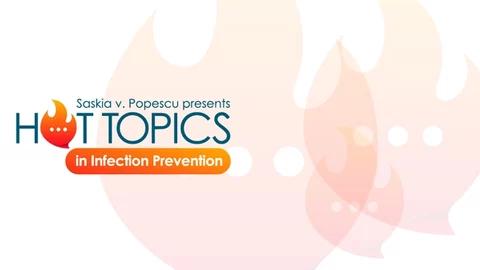IC Today Hot Topics: COVID-19 Readiness, Meningococcal Outbreak, and Norovirus
In this Hot Topics in IPC, Saskia v. Popescu, PhD, MPH, MA, CIC, FAPIC, discusses whether masks need to return for COVID-19, Virginia’s outbreak, and interesting articles to read.
In this Hot Topics in IPC, Saskia v. Popescu, PhD, MPH, MA, CIC, FAPIC, discusses whether masks need to return for COVID-19, Virginia’s outbreak, and interesting articles to read.

COVID-19 Readiness
Are we ready for COVID this fall? This question has increasingly been coming up, and the truth is, I can’t in confidence say “yes”. Katherine Wu, PhD, and a staff writer for The Atlantic, recently drew attention to this regarding masking mandates and hospital efforts, thus highlighting the challenges hospital infection preventionists (IPs) and epidemiologists face when it comes to mask mandates in the fourth year of the COVID-19 pandemic. “But across hospitals and policies, infection-prevention experts shared one sentiment: They felt almost certain that the masks would need to return, likely by the end of the calendar year. The big question was exactly when,” Wu wrote. This will be an increasingly common discussion as we move closer to the winter months and hospitals and IPs work to integrate a nonemergent COVID-19 pandemic into respiratory virus season response and restrictions.
Realistically, we’re likely to see increases in cases–whether that’s a true surge, or not–as people go back to pre-COVID-19 habits. What data do we use? What thresholds should determine action, and what happens if COVID numbers are high but not influenza or RSV? More to come…but food for thought as we navigate this novel situation for so many of us.
Also, good news: BA.2.86, a new COVID variant, is likely less immune-evasive than previously feared.
Virginia is Fighting a Meningococcal Outbreak
Twenty-seven people have been affected by a statewide meningococcal disease outbreak in Virginia, including 5 who have died due to the infection. Neisseria meningitidis serogroup Y is the culprit and driving cases much higher than what the state normally sees. “So far, health officials haven't identified a common risk factor, though genetic sequencing of the bacteria suggests the infections are highly related. Most patients are Black or African American adults ages 30 to 60. Only one had received the MenACWY vaccine,” according to an article in CIDRAP.
“The VDH urged parents and healthcare providers to ensure that children receive all recommended vaccines, including MenACWY, which is recommended for adolescents before entering 7th grade, with a booster dose before 12th grade. The vaccine is also recommended for people who are at increased risk from the disease.”
Interesting Things to Read:
- CDC MMWR on Norovirus Outbreak via Oysters–Not particularly surprising, but nonetheless interesting to read. “On December 7, 2022, the Texas Department of State Health Services (DSHS) Public Health Region 6/5 South (PHR 6/5S) and DSHS Consumer Protection Division were notified by Galveston County Health District of 10 consumer complaints of illness after consumption of raw (9 complaints) and smoked (1) oysters at local restaurants during November 27 [to] December 4. Signs and symptoms began within 8 hours after consumption and included diarrhea, nausea, or vomiting. Initially, no consumers sought medical care. Oyster tags from 3 associated restaurant inspections determined that oysters were from Oyster Harvest Area TX 1 (TX 1) in Galveston Bay, Texas.”
- Long-term COVID and Health Problems—A large study of veterans is sharing insight into the impact of COVID-19 infections on long-term health, noting that they “found a dramatically increased risk of dozens of conditions including heart failure and fatigue, sometimes years postinfection. Overall, the team estimates, COVID-19’s public health impact is more than 50% greater than that of cancer or heart disease.”
Newsletter
Stay prepared and protected with Infection Control Today's newsletter, delivering essential updates, best practices, and expert insights for infection preventionists.
Reducing Hidden Risks: Why Sharps Injuries Still Go Unreported
July 18th 2025Despite being a well-known occupational hazard, sharps injuries continue to occur in health care facilities and are often underreported, underestimated, and inadequately addressed. A recent interview with sharps safety advocate Amanda Heitman, BSN, RN, CNOR, a perioperative educational consultant, reveals why change is overdue and what new tools and guidance can help.
New Study Explores Oral Vancomycin to Prevent C difficile Recurrence, But Questions Remain
July 17th 2025A new clinical trial explores the use of low-dose oral vancomycin to prevent Clostridioides difficile recurrence in high-risk patients taking antibiotics. While the data suggest a possible benefit, the findings stop short of statistical significance and raise red flags about vancomycin-resistant Enterococcus (VRE), underscoring the delicate balance between prevention and antimicrobial stewardship.
What Lies Beneath: Why Borescopes Are Essential for Verifying Surgical Instrument Cleanliness
July 16th 2025Despite their smooth, polished exteriors, surgical instruments often harbor dangerous contaminants deep inside their lumens. At the HSPA25 and APIC25 conferences, Cori L. Ofstead, MSPH, and her colleagues revealed why borescopes are an indispensable tool for sterile processing teams, offering the only reliable way to verify internal cleanliness and improve sterile processing effectiveness to prevent patient harm.
The Next Frontier in Infection Control: AI-Driven Operating Rooms
Published: July 15th 2025 | Updated: July 15th 2025Discover how AI-powered sensors, smart surveillance, and advanced analytics are revolutionizing infection prevention in the OR. Herman DeBoard, PhD, discusses how these technologies safeguard sterile fields, reduce SSIs, and help hospitals balance operational efficiency with patient safety.
Targeting Uncertainty: Why Pregnancy May Be the Best Time to Build Vaccine Confidence
July 15th 2025New national survey data reveal high uncertainty among pregnant individuals—especially first-time parents—about vaccinating their future children, underscoring the value of proactive engagement to strengthen infection prevention.